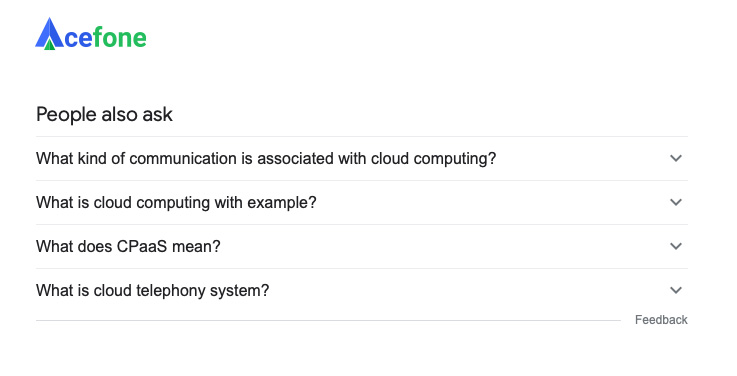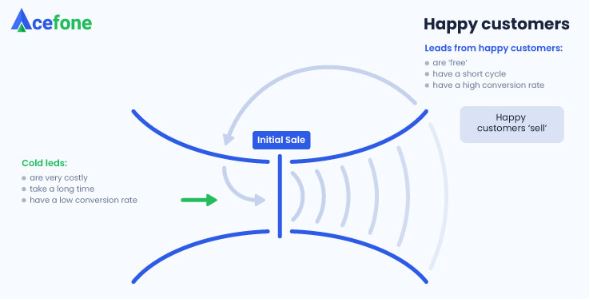There’s a saying that goes: you can’t clap with one hand.
A business doesn’t exist in silos. It involves people on either side of the graph—supply and demand, as it were. You cannot operate solely on numbers and business theories, with a one-track mind akin to a horse wearing blinkers.
What we’re getting at is the cycle of feedback. You can only ascertain how to modify and enhance your business strategies if you know what’s working and what’s not. And how do you do that?
You simply have to ask.
Make sure you collect customer reviews as well as employee feedback regularly for your different campaigns and processes. This can be done efficiently by adopting cloud-powered surveying tools. But we’ll get into that detail later.
Understanding feedback
Quite literally, we’re talking about a loop in a system where the output feeds back to the input. In the business sense of the word, recipients of the service help improve the work of the providers. So when a business listens to feedback it helps them make the product better.
Not only do you survey the clients and workers, but it’s also important to give performance reviews to your teams. Most commonly, you’d have heard of positive and negative feedback.
Clearly, these terms allude to the nature of the comments. Positive encouragement needs to be coupled with corrective feedback to create a healthy and well-functioning office. So while positive reviews reaffirm your high-performing practices, negative reviews can highlight problem areas that need to be worked on.
In fact, Harvard Business Review has found that though people might be hesitant to give negative feedback, they’d much rather receive these corrective comments to improve themselves further.
Every business, whether a small start-up or an established conglomerate, stands to benefit greatly from a proper feedback mechanism. Think of one of the biggest companies in the world—Google. Even a basic Google search comes with the feedback button, showing just how much the firm values it.

Let’s move on to the ‘why’
There is a certain appeal to comprehensive feedback. Why else is it so highly valued by companies of all sizes, sectors and locations?
Let’s look at it sectionally. Here’s why feedback is vital for all businesses:
#1 Customer feedback
a. Make better decisions
Managers and business owners often have to make crucial decisions for the betterment of the organisation. Armed with the right tools, you can efficiently collate customer feedback with performance metrics and other data. When you have all the relevant information in front of you, from quantitative analytics to qualitative comments, you can devise a superior action plan.
For example, if you’re holding a marketing campaign, you can couple the call answer rate, conversion rate and other such metrics with the survey answers you send out to the audience. So, if you find that the conversion rate is low for a certain campaign, you can pull up the feedback pertaining to that specific campaign, and figure out where the problem lies.
This enables you to make informed decisions and you can keep tweaking your strategies as the need arises.
b. Align supply and demand
Often, the only way to stand out in a saturated market is to provide clients with products that cater to their individual needs specifically. Feedback allows you to do just that. You can reallocate the funds for unpopular goods to produce those based on demand.
This ensures you don’t waste time, money and effort on low-return investments. Apart from the higher profits, you’re also left with a happier customer base whose needs are being met, while making them feel heard and valued.
c. Enhance customer experience
Needless to say, when you listen to customers, you can make sure they have consistently delightful experiences. After every call, you can leave a short survey or rating option that clients can use to assess their conversation. By considering these comments, your agents can deliver even better service.

#2 Employee feedback
a. Address operational issues
The reason your business is underperforming might very well be an internal issue. In that case, customer feedback would only give you half the picture. To exactly identify the leak, you need to ask the people involved—your employees.
Your team works day-in and day-out with the product. Their feedback can open your eyes to issues regarding equipment, bottlenecks in processes, or even overarching managerial problems. Once you address these issues, you’ll notice a significant increase in productivity.
b. Healthier work environment
Holding in negative emotions and frustration leads to lowered mental health in the long run. Rather than pushing employees to the breaking point, providing an avenue to air out their troubles with the system can act as a healthy outlet.
Not only will they feel relieved by being able to talk about their difficulties, but also you can actively and swiftly make the required changes.
c. Better communication and collaboration
By encouraging communication between hierarchies in the business, you can smoothen the flow of processes. The employees can even collaborate better when there is an improved communication system in place.
So, you can make sure that two teams are working together effectively and that any disputes can be taken up in their regular feedback sessions to be worked out.
Tips for totally effective feedback
We’ve discussed why stakeholder reviews are important. So naturally, the next step is how to do it. There are some simple steps you can take to get the best results out of your feedback cycle. Here are a few of them:
Cloud-powered communication
Of course, the first and most important step in taking feedback is equipping yourself with the right tools. After all, you can’t go shopping without a wallet, can you?
Cloud offers the perfect solutions to hold large-scale feedback campaigns virtually. You can connect with a larger audience for a fraction of the cost, collect their responses accurately, and automatically store the information on a secure cloud server.
Here are some features you need to try out:
- Outbound IVR: an automated outbound call or SMS equipped with a predefined IVR menu. You can get survey answers or ratings by assigning answers to different digits and recording keypad inputs. Through this option, you can reach out to a multitude of people with minimal effort.
- Auto-notification SMS: It’s a good idea to send a follow-up SMS after your customer call ends. This SMS can ask for feedback regarding the conversation and their satisfaction level. At the same time, you can deliver any extra information and reiterate your contact details.
- CRM integration: This tool expertly collates your collected feedback into your phone system. So all your call details, customer information, as well as their feedback, is present on one single portal for easy access and management.
- In-chat polls for teams: For employee feedback, it might be convenient to send out polls and surveys on the instant messaging platform. You can send out the message to all your teams in a single or strategically separated chat room as well.
These are just a few options. Once you dive into the cloud communication platform, you’ll find many more ways to better collect, review and utilise data.
Be proactive and timely
You’ll only receive transparent reviews when people feel like their opinion matters. For this, you need to be proactive and show that you’re willing to take whatever steps are necessary to get the required feedback.
Send out surveys to your stakeholders, use follow-up calls and SMSes right as your conversation ends, and most importantly, be regular in your endeavours.
At the same time, you need to be timely in assessing the recorded responses and accordingly acting on them. The measures you take are the actual indicators of your commitment to the feedback process—and that’s how you build trust among everyone involved.
Stress on analysis and insights
The feedback collected needs to be properly collated and made sense of. The cloud offers real-time performance monitoring tools as well as regularly generated reports that compile the data.
These reports are personalised and you can make them as visual as you want for experts and laymen alike. Furthermore, schedule them to be emailed to your or your agents’ inbox automatically so you never miss out.
Creating the perfect survey
There’s no perfect mould for creating a successful survey. However, there are some general thumb rules that can help enhance it.
The first thing to keep in mind is to keep it succinct. Don’t assume that customers or employees have the time to read through long texts and do a thorough analysis every time they get contacted.
Sometimes you may require one-word answers, sometimes you need multiple options, while some other times a simple choice between two options is enough. For example, when you select ‘not interested’ on a YouTube video, you get a tiny survey asking why:

However, to get more detailed information, you can send out comprehensive surveys on a less frequent basis. People will be more likely to take out their time to fill out these forms this way.
You can also mix and match the style of questions. So you could start off with open-ended ones and branch off to specific MCQs as people enter their inputs.
Keep monitoring the feedback campaigns
Of course, all these efforts are in vain if you lose out on using the acquired information in a timely manner.
On a cloud portal, you can access a real-time dashboard with live metrics as well as the option to receive exhaustive compiled reports. Do make sure that you keep tracking the incoming feedback—from all the sources.
And accordingly, keep making changes to business strategies. It’s best to act as swiftly as possible so that the stakeholders are encouraged to keep sending in their honest feedback.
Conclusion
As the world gets more deeply connected with technology, people are increasingly realising the importance of communication—especially in business. The feedback mechanism connects both ends of the relationship, fostering two-way growth.
It’s vital that businesses realise this for them to be able to make sound decisions and cater to what the public really wants and what the employees really need. Go ahead and try it out now!














